Spatiotemporal Responses of Vegetation to Hydroclimatic Factors over Arid and Semi-arid Climate
Abstract
:1. Introduction
2. Materials and Methods
2.1. Study Area
2.2. Data Set
2.3. Downloading and Processing of Satellite Data
2.3.1. NDVI
2.3.2. Rainfall
2.3.3. Land Surface Temperature
2.3.4. Evapotranspiration (ET)
2.4. Trend Analysis
2.5. Relationship of Vegetative Indices with Hydroclimatic Factors
3. Results
3.1. Rainfall
3.1.1. Characterization of Annual Change
3.1.2. Characterization of Intra-Annual Change
3.1.3. Characterization of Spatial Change
3.1.4. Trend Analysis for Rainfall
3.2. Land Surface Temperature
3.2.1. Characterization of Annual Change
3.2.2. Characterization of Intra-Annual Change
3.2.3. Characterization of Spatial Change
3.2.4. Trend Analysis of LST
3.3. Evapotranspiration
3.3.1. Characterization of Annual Change
3.3.2. Characterization of Intra-Annual Change
3.3.3. Characterization of Spatial Change
3.3.4. Trend Analysis of ET
3.4. Normalized Difference Vegetation Index (NDVI)
3.4.1. Characterization of Annual Change
3.4.2. Characterization of Intra-Annual Change
3.4.3. Characterization of Spatial Change
3.4.4. Trend Analysis of NDVI
3.5. Correlation between Hydroclimatic Parameters and Vegetative Indices
4. Discussion
4.1. Spatiotemporal Variation in Rainfall
4.2. Spatiotemporal Variation in Land Surface Temperature
4.3. Spatiotemporal Variation in Evapotranspiration
4.4. Spatiotemporal Variation in NDVI
4.5. Correlation between Hydroclimatic Parameters and Vegetative Index
5. Conclusions
Author Contributions
Funding
Institutional Review Board Statement
Informed Consent Statement
Data Availability Statement
Acknowledgments
Conflicts of Interest
References
- Kundu, A.; Denis, D.M.; Patel, N.R.; Dutta, D. Long-Term Trend of Vegetation in Bundelkhand Region (India): An Assessment Through SPOT-VGT NDVI Datasets. In Climate Change, Extreme Events and Disaster Risk Reduction; Springer: Cham, Switzerland, 2018; pp. 89–99. [Google Scholar]
- Liu, Y.; Lei, H. Responses of natural vegetation dynamics to climate drivers in China from 1982 to 2011. Remote Sens. 2015, 7, 10243–10268. [Google Scholar] [CrossRef]
- Huang, F.; Xu, S. Spatio-temporal variations of rain-use efficiency in the west of Songliao Plain, China. Sustainability 2016, 8, 308. [Google Scholar] [CrossRef]
- Srivastava, A.; Rodriguez, J.F.; Saco, P.M.; Kumari, N.; Yetemen, O. Global Analysis of Atmospheric Transmissivity Using Cloud Cover, Aridity and Flux Network Datasets. Remote Sens. 2021, 13, 1716. [Google Scholar] [CrossRef]
- Hou, W.; Gao, J.; Wu, S.; Dai, E. Interannual variations in growing-season NDVI and its correlation with climate variables in the southwestern karst region of China. Remote Sens. 2015, 7, 11105–11124. [Google Scholar] [CrossRef]
- Wu, C.; Venevsky, S.; Sitch, S.; Yang, Y.; Wang, M.; Wang, L.; Gao, Y. Present-day and future contribution of climate and fires to vegetation composition in the boreal forest of China. Ecosphere 2017, 8, e01917. [Google Scholar] [CrossRef]
- Scheffer, M.; Holmgren, M.; Brovkin, V.; Claussen, M. Synergy between small-and large-scale feedbacks of vegetation on the water cycle. Glob. Change Biol. 2005, 11, 1003–1012. [Google Scholar] [CrossRef]
- Quillet, A.; Peng, C.; Garneau, M. Toward dynamic global vegetation models for simulating vegetation–climate interactions and feedbacks: Recent developments, limitations, and future challenges. Environ. Rev. 2010, 18, 333–353. [Google Scholar] [CrossRef]
- Hamid, M.; Khuroo, A.A.; Malik, A.H.; Ahmad, R.; Singh, C.P.; Dolezal, J.; Haq, S.M. Early evidence of shifts in alpine summit vegetation: A case study from Kashmir Himalaya. Front. Plant Sci. 2020, 11, 421. [Google Scholar] [CrossRef]
- Kumari, N.; Srivastava, A.; Dumka, U.C. A long-term spatiotemporal analysis of vegetation greenness over the himalayan region using google earth engine. Climate 2021, 9, 109. [Google Scholar] [CrossRef]
- Kumar, K.C.A.; Reddy, G.P.O.; Masilamani, P.; Sandeep, P.; Turkar, S.Y. Integrated drought monitoring index: A tool to monitor agricultural drought by using time series space-based earth observation satellite datasets. Adv. Space Res. 2021, 67, 298–315. [Google Scholar] [CrossRef]
- Singh, R.N.; Sah, S.; Chaturvedi, G.; Das, B.; Pathak, H. Innovative trend analysis of rainfall in relation to soybean productivity over western Maharashtra. J. Agrometeorol. 2021, 23, 228–235. [Google Scholar] [CrossRef]
- Singh, R.N.; Sah, S.; Das, B.; Chaturvedi, G.; Kumar, M.; Rane, J.; Pathak, H. Long-term spatiotemporal trends of temperature associated with sugarcane in west India. Arab. J. Geosci. 2021, 14, 1955. [Google Scholar] [CrossRef]
- Sur, K.; Dave, R.; Chauhan, P. Spatio-temporal changes in NDVI and rainfall over Western Rajasthan and Gujarat region of India. J. Agrometeorol. 2018, 20, 189–195. [Google Scholar]
- Mariano, D.A.; dos Santos, C.A.; Wardlow, B.D.; Anderson, M.C.; Schiltmeyer, A.V.; Tadesse, T.; Svoboda, M.D. Use of remote sensing indicators to assess effects of drought and human-induced land degradation on ecosystem health in Northeastern Brazil. Remote Sens. Environ. 2018, 213, 129–143. [Google Scholar] [CrossRef]
- Guo, E.; Wang, Y.; Wang, C.; Sun, Z.; Bao, Y.; Mandula, N.; Jirigala, B.; Bao, Y.; Li, H. NDVI indicates long-term dynamics of vegetation and its driving forces from climatic and anthropogenic factors in Mongolian Plateau. Remote Sens. 2021, 13, 688. [Google Scholar] [CrossRef]
- Rihan, W.; Zhang, H.; Zhao, J.; Shan, Y.; Guo, X.; Ying, H.; Deng, G.; Li, H. Promote the advance of the start of the growing season from combined effects of climate change and wildfire. Ecol. Indicat. 2021, 125, 107483. [Google Scholar] [CrossRef]
- Zeng, Z.; Wu, W.; Ge, Q.; Li, Z.; Wang, X.; Zhou, Y.; Zhang, Z.; Li, Y.; Huang, H.; Liu, G.; et al. Legacy effects of spring phenology on vegetation growth under preseason meteorological drought in the Northern Hemisphere. Agric. For. Meteorol. 2021, 310, 108630. [Google Scholar] [CrossRef]
- Bai, Y.; Li, S.; Liu, M.; Guo, Q. Assessment of vegetation change on the Mongolian Plateau over three decades using different remote sensing products. J. Environ. Manag. 2022, 317, 115509. [Google Scholar] [CrossRef]
- Nemani, R.R.; Keeling, C.D.; Hashimoto, H.; Jolly, W.M.; Piper, S.C.; Tucker, C.J.; Myneni, R.B.; Running, S.W. Climate-driven increases in global terrestrial net primary production from 1982 to 1999. Science 2003, 300, 1560–1563. [Google Scholar] [CrossRef]
- Zhu, Z. Change detection using landsat time series: A review of frequencies, preprocessing, algorithms, and applications. ISPRS J. Photogramm. Remote Sens. 2017, 130, 370–384. [Google Scholar] [CrossRef]
- Srivastava, A.; Sahoo, B.; Raghuwanshi, N.S.; Singh, R. Evaluation of variable-infiltration capacity model and MODIS-terra satellite-derived grid-scale evapotranspiration estimates in a River Basin with Tropical Monsoon-Type climatology. J. Irrig. Drain. Eng. 2017, 143, 04017028. [Google Scholar] [CrossRef]
- Piao, S.; Wang, X.; Park, T.; Chen, C.; Lian, X.U.; He, Y.; Bjerke, J.W.; Chen, A.; Ciais, P.; Tømmervik, H.; et al. Characteristics, drivers and feedbacks of global greening. Nat. Rev. Earth Environ. 2020, 1, 14–27. [Google Scholar] [CrossRef]
- Venter, Z.S.; Scott, S.L.; Desmet, P.G.; Hoffman, M.T. Application of Landsat-derived vegetation trends over South Africa: Potential for monitoring land degradation and restoration. Ecol. Indic. 2020, 113, 106206. [Google Scholar] [CrossRef]
- Huete, A. Vegetation’s responses to climate variability. Nature 2016, 531, 181–182. [Google Scholar] [CrossRef]
- Yang, J.; Gong, P.; Fu, R.; Zhang, M.; Chen, J.; Liang, S.; Xu, B.; Shi, J.; Dickinson, R. The role of satellite remote sensing in climate change studies. Nat. Clim. Change 2013, 3, 875–883. [Google Scholar] [CrossRef]
- Wardlow, B.D.; Egbert, S.L. A comparison of MODIS 250-m EVI and NDVI data for crop mapping: A case study for southwest Kansas. Int. J. Remote Sens. 2010, 31, 805–830. [Google Scholar] [CrossRef]
- Hereher, M.E. The status of Egypt’s agricultural lands using MODIS Aqua data. Egypt. J. Remote Sens. Space Sci. 2013, 16, 83–89. [Google Scholar]
- Garroutte, E.L.; Hansen, A.J.; Lawrence, R.L. Using NDVI and EVI to map spatiotemporal variation in the biomass and quality of forage for migratory elk in the Greater Yellowstone Ecosystem. Remote Sens. 2016, 8, 404. [Google Scholar] [CrossRef]
- Reddy, G.P.O.; Kumar, N.; Sahu, N.; Srivastava, R.; Singh, S.K.; Naidu, L.G.K.; Chary, G.R.; Biradar, C.M.; Gumma, M.K.; Reddy, B.S.; et al. Assessment of spatio-temporal vegetation dynamics in tropical arid ecosystem of India using MODIS time-series vegetation indices. Arab. J. Geosci. 2020, 13, 704. [Google Scholar] [CrossRef]
- Dutta, D.; Kundu, A.; Patel, N.R.; Saha, S.K.; Siddiqui, A.R. Assessment of agricultural drought in Rajasthan (India) using remote sensing derived Vegetation Condition Index (VCI) and Standardized Precipitation Index (SPI). Egypt. J. Remote Sens. Space Sci. 2015, 18, 53–63. [Google Scholar] [CrossRef]
- Matsushita, B.; Yang, W.; Chen, J.; Onda, Y.; Qiu, G. Sensitivity of the enhanced vegetation index (EVI) and normalized difference vegetation index (NDVI) to topographic effects: A case study in high-density cypress forest. Sensors 2007, 7, 2636–2651. [Google Scholar] [CrossRef]
- Saini, D.; Bhardwaj, P.; Singh, O. Recent rainfall variability over Rajasthan, India. Theor. Appl. Climatol. 2021, 148, 363–381. [Google Scholar] [CrossRef]
- Chen, J.; Jönsson, P.; Tamura, M.; Gu, Z.; Matsushita, B.; Eklundh, L. A simple method for reconstructing a high-quality NDVI time-series data set based on the Savitzky–Golay filter. Remote Sens. Environ. 2004, 91, 332–344. [Google Scholar] [CrossRef]
- Yadav, B.; Malav, L.C.; Jiménez-Ballesta, R.; Kumawat, C.; Patra, A.; Patel, A.; Jangir, A.; Nogiya, M.; Meena, R.L.; Moharana, P.C.; et al. Modeling and assessment of land degradation vulnerability in arid ecosystem of Rajasthan using analytical hierarchy process and geospatial techniques. Land 2023, 12, 106. [Google Scholar] [CrossRef]
- Wan, Z. Collection-6 MODIS Land Surface Temperature Products Users’ Guide. 2013. Available online: https://lpdaac.usgs.gov/documents/118/MOD11_User_Guide_V6.pdf (accessed on 29 July 2023).
- Malav, L.C.; Yadav, B.; Tailor, B.L.; Pattanayak, S.; Singh, S.V.; Kumar, N.; Reddy, G.P.; Mina, B.L.; Dwivedi, B.S.; Jha, P.K. Mapping of land degradation vulnerability in the semi-arid watershed of Rajasthan, India. Sustainability 2022, 14, 10198. [Google Scholar] [CrossRef]
- Srivastava, A.; Sahoo, B.; Raghuwanshi, N.S.; Chatterjee, C. Modelling the dynamics of evapotranspiration using Variable Infiltration Capacity model and regionally calibrated Hargreaves approach. Irrig. Sci. 2018, 36, 289–300. [Google Scholar] [CrossRef]
- Mann, H.B. Nonparametric Tests against Trend. Econometrica 1945, 13, 245–259. [Google Scholar] [CrossRef]
- Kendall, M.G. Rank Correlation Methods, 4th ed.; Charles Grifin: London, UK, 1975. [Google Scholar]
- Hamed, K.H.; Rao, A.R. A Modified Mann-Kendall Trend Test for Autocorrelated Data. J. Hydrol. 1998, 204, 182–196. [Google Scholar] [CrossRef]
- Hansen, B.E. Challenges for econometric model selection. Econom. Theory 2005, 21, 60–68. [Google Scholar] [CrossRef]
- Sen, P.K. Estimates of the Regression Coefficient Based on Kendall’s Tau. J. Am. Stat. Assoc. 1968, 63, 1379–1389. [Google Scholar] [CrossRef]
- Theil, H. A Rank-Invariant Method of Linear and Polynomial Regression Analysis, Part I; Confidence Regions for the Parameters of Polynomial Regression Equations. Proc. R. Neth. Acad. Sci. 1950, 53, 386–392. [Google Scholar]
- Mahala, B.K.; Nayak, B.K.; Mohanty, P.K. Impacts of ENSO and IOD on tropical cyclone activity in the Bay of Bengal. Nat. Hazards 2015, 75, 1105–1125. [Google Scholar] [CrossRef]
- Bhardwaj, P.; Pattanaik, D.R.; Singh, O. Tropical cyclone activity over Bay of Bengal in relation to El Niño-Southern Oscillation. Int. J. Climatol. 2019, 39, 5452–5469. [Google Scholar] [CrossRef]
- Meena, H.M.; Machiwal, D.; Santra, P.; Moharana, P.C.; Singh, D.V. Trends and homogeneity of monthly, seasonal, and annual rainfall over arid region of Rajasthan, India. Theor. Appl. Climatol. 2019, 136, 795–811. [Google Scholar] [CrossRef]
- Sharma, S.K.; Sharma, D.P.; Sharma, M.K.; Gaur, K.; Manohar, P. Trend Analysis of Temperature and Rainfall of Rajasthan, India. J. Probab. Stat. 2021, 2021, 6296709. [Google Scholar] [CrossRef]
- Yadav, R.K.; Rupa Kumar, K.; Rajeevan, M. Characteristic features of winter precipitation and its variability over north-west India. J. Earth Syst. Sci. 2012, 121, 611–623. [Google Scholar] [CrossRef]
- Narain, P.; Rathore, L.S.; Singh, R.S.; Rao, A.S. Drought Assessment and Management in Arid Rajasthan; Central Arid Zone Research Institute; Jodhpur and NCMRWF: Noida, India, 2006; p. 64. [Google Scholar]
- Kundu, A.; Dutta, D. Monitoring desertification risk through climate change and human interference using remote sensing and GIS techniques. Int. J. Geomat. Geosci. 2011, 2, 21. [Google Scholar]
- Pant, G.B.; Hingane, L.S. Climatic changes in and around the Rajasthan desert during the 20th century. J. Climatol. 1988, 8, 391–401. [Google Scholar] [CrossRef]
- Singh, R.S.; Narain, P.; Sharma, K.D. Climate changes in Luni river basin of arid western Rajasthan (India). Vayu Mandal 2001, 31, 103–106. [Google Scholar]
- Basistha, A.; Goel, N.K.; Arya, D.S.; Gangwar, S.K. Spatial pattern of trends in Indian sub-divisional rainfall. Jalvigyan Sameeksha 2007, 22, 47–57. [Google Scholar]
- Kharol, S.K.; Kaskaoutis, D.G.; Badarinath, K.V.S.; Sharma, A.R.; Singh, R.P. Influence of land use/land cover (LULC) changes on atmospheric dynamics over the arid region of Rajasthan state, India. J. Arid Environ. 2013, 88, 90–101. [Google Scholar] [CrossRef]
- Kumar, V.; Jain, S.K.; Singh, Y. Analysis of long-term rainfall trends in India. Hydrolog. Sci. J. 2010, 55, 484–496. [Google Scholar] [CrossRef]
- Singh, R.N.; Sah, S.; Das, B.; Potekar, S.; Chaudhary, A.; Pathak, H. Innovative trend analysis of spatio-temporal variations of rainfall in India during 1901–2019. Theor. Appl. Climatol. 2021, 145, 821–838. [Google Scholar] [CrossRef]
- Deoli, V.; Rana, S. Seasonal trend analysis in rainfall and temperature for Udaipur district of Rajasthan. Curr. World Environ. 2017, 14, 312. [Google Scholar] [CrossRef]
- Goswami, B.N.; Venugopal, V.; Sengupta, D.; Madhusoodanan, M.S.; Xavier, P.K. Increasing trend of extreme rain events over India in a warming environment. Science 2006, 314, 1442–1445. [Google Scholar] [CrossRef] [PubMed]
- Rajeevan, M.; Bhate, J.; Jaswal, A.K. Analysis of variability and trends of extreme rainfall events over India using 104 years of gridded daily rainfall data. Geophys. Res. Lett. 2008, 35, 1–6. [Google Scholar]
- Lacombe, G.; McCartney, M. Uncovering consistencies in Indian rainfall trends observed over the last half century. Clim. Change 2014, 123, 287–299. [Google Scholar] [CrossRef]
- Poonia, S.; Rao, A.S. Climate change and its impact on Thar desert ecosystem. J. Agric. Phy. 2013, 13, 71–79. [Google Scholar]
- Khandelwal, S.; Goyal, R.; Kaul, N.; Mathew, A. Assessment of land surface temperature variation due to change in elevation of area surrounding Jaipur, India. Egypt. J. Remote Sens. Space Sci. 2018, 21, 87–94. [Google Scholar]
- Dos Santos, C.A.; Mariano, D.A.; Francisco das Chagas, A.; Dantas, F.R.D.C.; de Oliveira, G.; Silva, M.T.; da Silva, L.L.; da Silva, B.B.; Bezerra, B.G.; Safa, B.; et al. Spatio-temporal patterns of energy exchange and evapotranspiration during an intense drought for drylands in Brazil. Int. J. Appl. Earth Obs. Geoinf. 2020, 85, 101982. [Google Scholar] [CrossRef]
- Pal, S.; Ziaul, S.K. Detection of land use and land cover change and land surface temperature in English Bazar urban centre. Egypt. J. Remote Sens. Space Sci. 2017, 20, 125–145. [Google Scholar]
- Dutta, S.; Chaudhuri, G. Evaluating environmental sensitivity of arid and semi-arid regions in northeastern Rajasthan, India. Geogr. Rev. 2015, 105, 441–461. [Google Scholar] [CrossRef]
- Hicham, B.; Abbou, A.; Abousserhane, Z. Model for maximizing fixed photovoltaic panel efficiency without the need to change the tilt angle of monthly or seasonal frequency. In Proceedings of the 2022 2nd International Conference on Innovative Research in Applied Science, Engineering and Technology (IRASET), Meknes, Morocco, 3–4 March 2022; pp. 1–5. [Google Scholar]
- Peng, J.; Jia, J.; Liu, Y.; Li, H.; Wu, J. Seasonal contrast of the dominant factors for spatial distribution of land surface temperature in urban areas. Remote Sens. Environ. 2018, 215, 255–267. [Google Scholar] [CrossRef]
- Lakra, K.; Sharma, D. Geospatial assessment of urban growth dynamics and land surface temperature in Ajmer Region, India. J. Indian Soc. Remote Sens. 2019, 47, 1073–1089. [Google Scholar] [CrossRef]
- Dhakar, R.; Sehgal, V.K.; Pradhan, S. Study on inter-seasonal and intra-seasonal relationships of meteorological and agricultural drought indices in the Rajasthan State of India. J. Arid Environ. 2013, 97, 108–119. [Google Scholar] [CrossRef]
- Sur, K.; Chauhan, P. Dynamic trend of land degradation/restoration along Indira Gandhi Canal command area in Jaisalmer District, Rajasthan, India: A case study. Environ. Earth Sci. 2019, 78, 472. [Google Scholar] [CrossRef]
- Asoka, A.; Wardlow, B.; Tsegaye, T.; Huber, M.; Mishra, V. A Satellite-Based Assessment of the Relative Contribution of Hydroclimatic Variables on Vegetation Growth in Global Agricultural and Nonagricultural Regions. J. Geophys. Res. Atmos. 2021, 126, e2020JD033228. [Google Scholar] [CrossRef]
- Zhou, R.; Wang, H.; Duan, K.; Liu, B. Diverse responses of vegetation to hydroclimate across temporal scales in a humid subtropical region. J. Hydrol. Reg. Stud. 2021, 33, 100775. [Google Scholar] [CrossRef]
- Ukasha, M.; Ramirez, J.A.; Niemann, J.D. Temporal Variations of NDVI and LAI and Interactions With Hydroclimatic Variables in a Large and Agro-Ecologically Diverse Region. J. Geophys. Res. Biogeosci. 2022, 127, e2021JG006395. [Google Scholar] [CrossRef]
- Li, G.; Zhang, F.; Jing, Y.; Liu, Y.; Sun, G. Response of evapotranspiration to changes in land use and land cover and climate in China during 2001–2013. Sci. Total Environ. 2017, 596, 256–265. [Google Scholar] [CrossRef] [PubMed]
- Goroshi, S.; Pradhan, R.; Singh, R.P.; Singh, K.K.; Parihar, J.S. Trend analysis of evapotranspiration over India: Observed from long-term satellite measurements. J. Earth Syst. Sci. 2017, 126, 113. [Google Scholar] [CrossRef]
- Goyal, R.K. Sensitivity of evapotranspiration to global warming: A case study of arid zone of Rajasthan (India). Agric. Water Manag. 2004, 69, 1–11. [Google Scholar] [CrossRef]
- Madhu, S.; Kumar, T.V.; Barbosa, H.; Rao, K.K.; Bhaskar, V.V. Trend analysis of evapotranspiration and its response to droughts over India. Theor. Appl. Climatol. 2015, 121, 41–51. [Google Scholar] [CrossRef]
- Matzneller, P.; Ventura, F.; Gaspari, N.; Rossi Pisa, P. Analysis of climatic trends in data from the agrometeorological station of Bologna-Cadriano, Italy (1952–2007). Clim. Change 2010, 100, 717–731. [Google Scholar] [CrossRef]
- Gholkar, M.D.; Goroshi, S.; Singh, R.P.; Parihar, J.S. Influence of agricultural developments on net primary productivity (NPP) in the semi-arid region of India: A study using GloPEM model. Int. Arch. Photogramm. Remote Sens. Spat. Inf. Sci. 2014, 40, 725. [Google Scholar] [CrossRef]
- Mathew, A.; Khandelwal, S.; Kaul, N. Investigating spatial and seasonal variations of urban heat island effect over Jaipur city and its relationship with vegetation, urbanization and elevation parameters. Sustain. Cities Soc. 2017, 35, 157–177. [Google Scholar] [CrossRef]
- Guan, X.; Shen, H.; Li, X.; Gan, W.; Zhang, L. A long-term and comprehensive assessment of the urbanization-induced impacts on vegetation net primary productivity. Sci. Total Environ. 2019, 669, 342–352. [Google Scholar] [CrossRef]
- Lyu, R.; Zhang, J.; Xu, M.; Li, J. Impacts of urbanization on ecosystem services and their temporal relations: A case study in Northern Ningxia, China. Land Use Policy 2018, 77, 163–173. [Google Scholar] [CrossRef]
- Yao, R.; Wang, L.; Huang, X.; Guo, X.; Niu, Z.; Liu, H. Investigation of urbanization effects on land surface phenology in Northeast China during 2001–2015. Remote Sens. 2017, 9, 66. [Google Scholar] [CrossRef]
- Du, J.; Fu, Q.; Fang, S.; Wu, J.; He, P.; Quan, Z. Effects of rapid urbanization on vegetation cover in the metropolises of China over the last four decades. Ecol. Indic. 2019, 107, 105458. [Google Scholar] [CrossRef]
- Budde, M.E.; Tappan, G.; Rowland, J.; Lewis, J.; Tieszen, L.L. Assessing land cover performance in Senegal, West Africa using 1-km integrated NDVI and local variance analysis. J. Arid Environ. 2004, 59, 481–498. [Google Scholar] [CrossRef]
- Wang, J.; Rich, P.M.; Price, K.P. Temporal responses of NDVI to precipitation and temperature in the central Great Plains, USA. Int. J. Remote Sens. 2003, 24, 2345–2364. [Google Scholar] [CrossRef]
- Ji, L.; Peters, A.J. A spatial regression procedure for evaluating the relationship between AVHRR-NDVI and climate in the northern Great Plains. Int. J. Remote Sens. 2004, 25, 297–311. [Google Scholar] [CrossRef]
- Moses, O.; Blamey, R.C.; Reason, C.J. Relationships between NDVI, river discharge and climate in the Okavango River Basin region. Int. J. Climatol. 2022, 42, 691–713. [Google Scholar] [CrossRef]
- Rao, A.S. Climatic changes in the irrigated tracts of Indira Gandhi Canal Region of arid western Rajasthan, India. Ann. Arid Zone 1996, 35, 111–116. [Google Scholar]
- Malik, D. Without Rain, a Bleak Outlook, India Together. The News in Proportion, 29 March 2014. 29 March.
- Dangayach, R.; Jain, R.; Pandey, A.K. Long-term variation in aerosol optical depth and normalized difference vegetation index in Jaipur, India. Total Environ. Res. Themes 2023, 5, 100027. [Google Scholar] [CrossRef]
- Raymondi, R.R.; Cuhaciyan, J.E.; Glick, P.; Capalbo, S.M.; Houston, L.L.; Shafer, S.L.; Grah, O. Water resources: Implications of changes in temperature and precipitation. In Climate Change in the Northwest: Implications for Our Landscapes, Waters, and Communities; Island Press: Washington, DC, USA, 2013; pp. 41–66. [Google Scholar]
- Zhang, H.; Chang, J.; Zhang, L.; Wang, Y.; Li, Y.; Wang, X. NDVI dynamic changes and their relationship with meteorological factors and soil moisture. Environ. Earth Sci. 2018, 77, 582. [Google Scholar] [CrossRef]
- Abera, T.A.; Heiskanen, J.; Pellikka, P.; Maeda, E.E. Rainfall–vegetation interaction regulates temperature anomalies during extreme dry events in the Horn of Africa. Glob. Planet. Change 2018, 167, 35–45. [Google Scholar] [CrossRef]
- Guha, S.; Govil, H. An assessment on the relationship between land surface temperature and normalized difference vegetation index. Environ. Dev. Sustain. 2021, 23, 1944–1963. [Google Scholar] [CrossRef]
- Rahaman, S.M.; Khatun, M.; Garai, S.; Das, P.; Tiwari, S. Forest Fire Risk Zone Mapping in Tropical Forests of Saranda, Jharkhand, Using FAHP Technique. In Geospatial Technology for Environmental Hazards: Modeling and Management in Asian Countries; Springer International Publishing: Berlin/Heidelberg, Germany, 2022; pp. 177–195. [Google Scholar]
- Garai, S.; Khatun, M.; Singh, R.; Sharma, J.; Pradhan, M.; Ranjan, A.; Rahaman, S.M.; Khan, M.L.; Tiwari, S. Assessing correlation between Rainfall, normalized difference Vegetation Index (NDVI) and land surface temperature (LST) in Eastern India. Saf. Extreme Environ. 2022, 4, 119–127. [Google Scholar] [CrossRef]
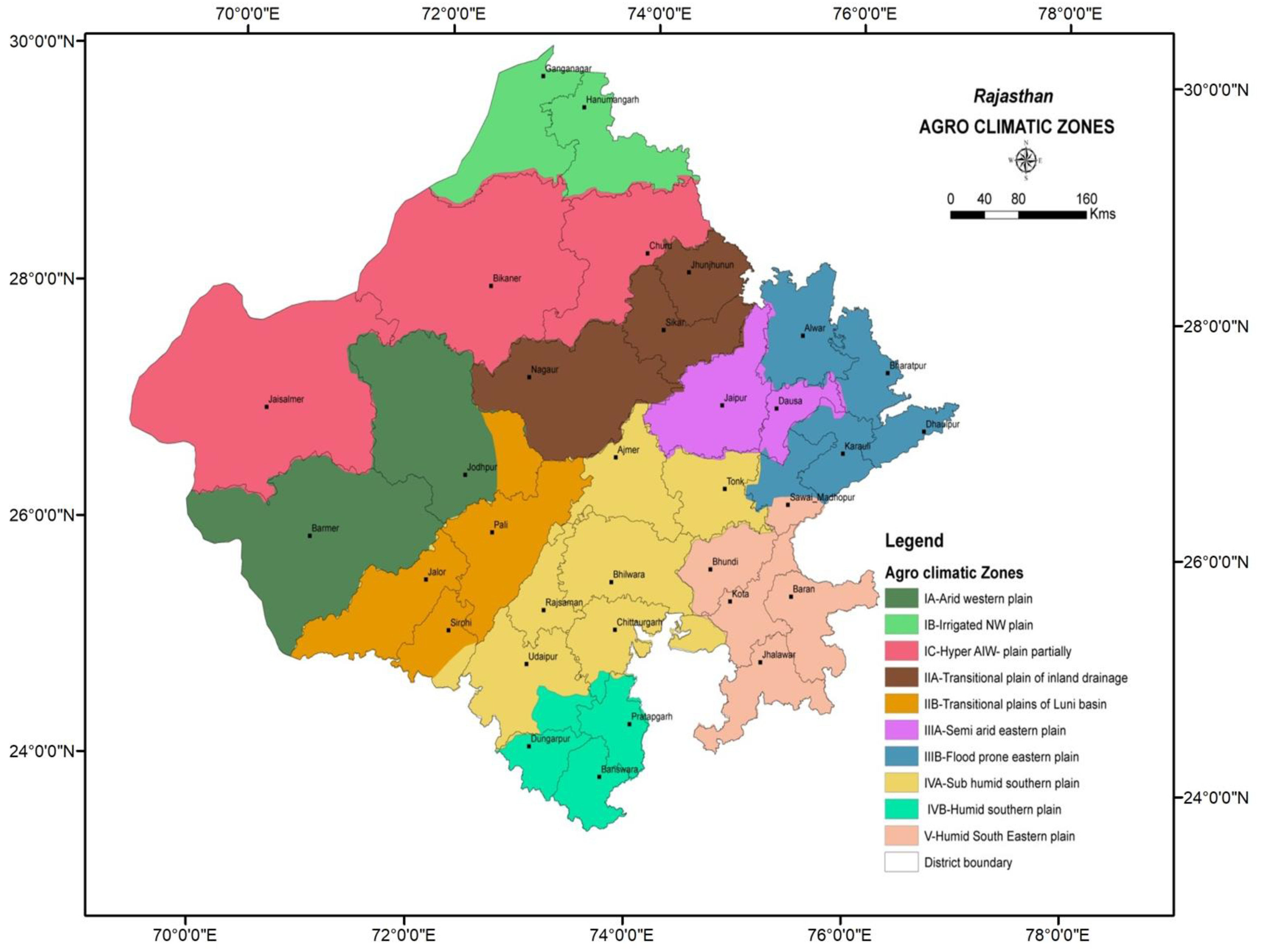







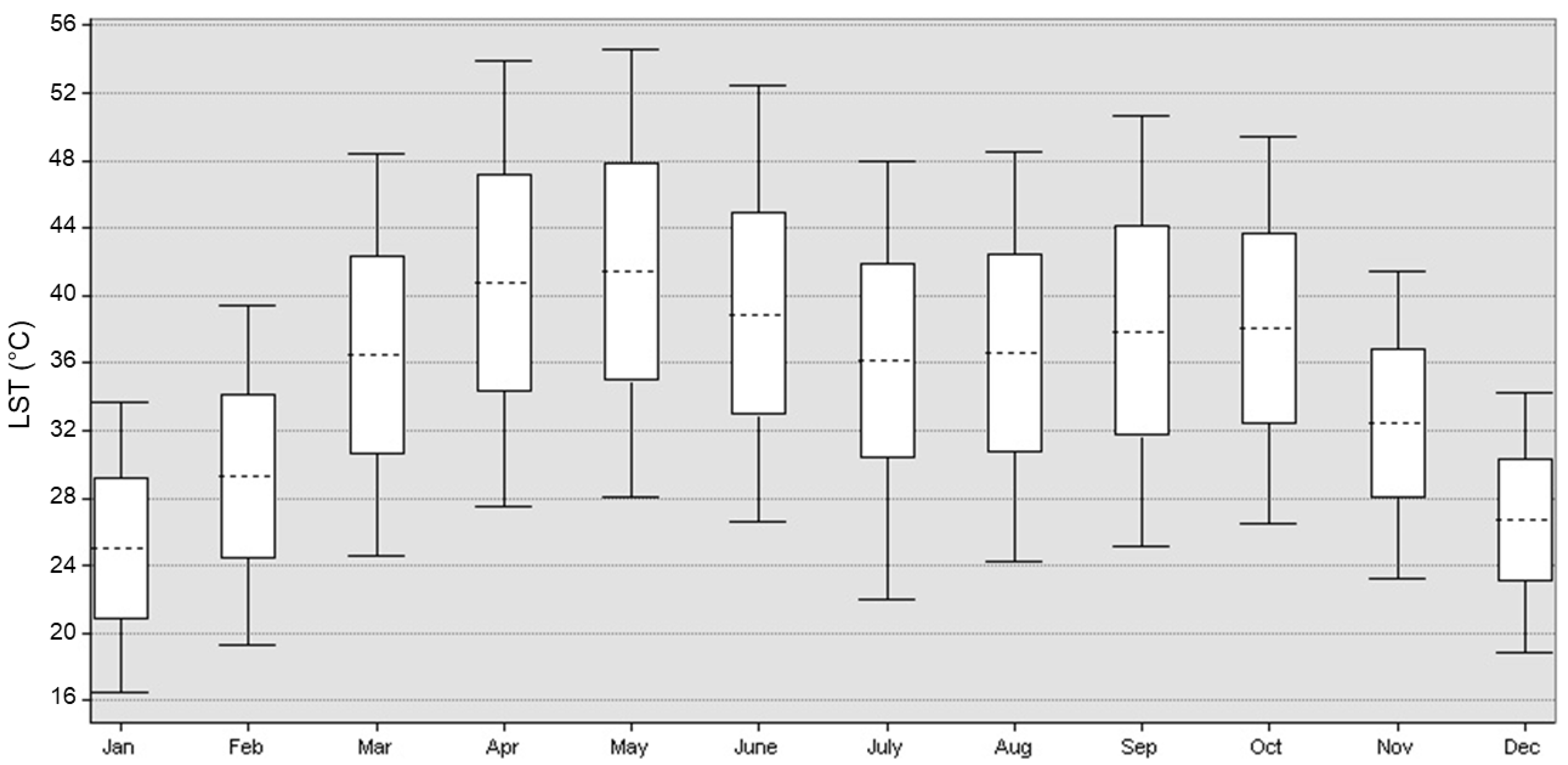

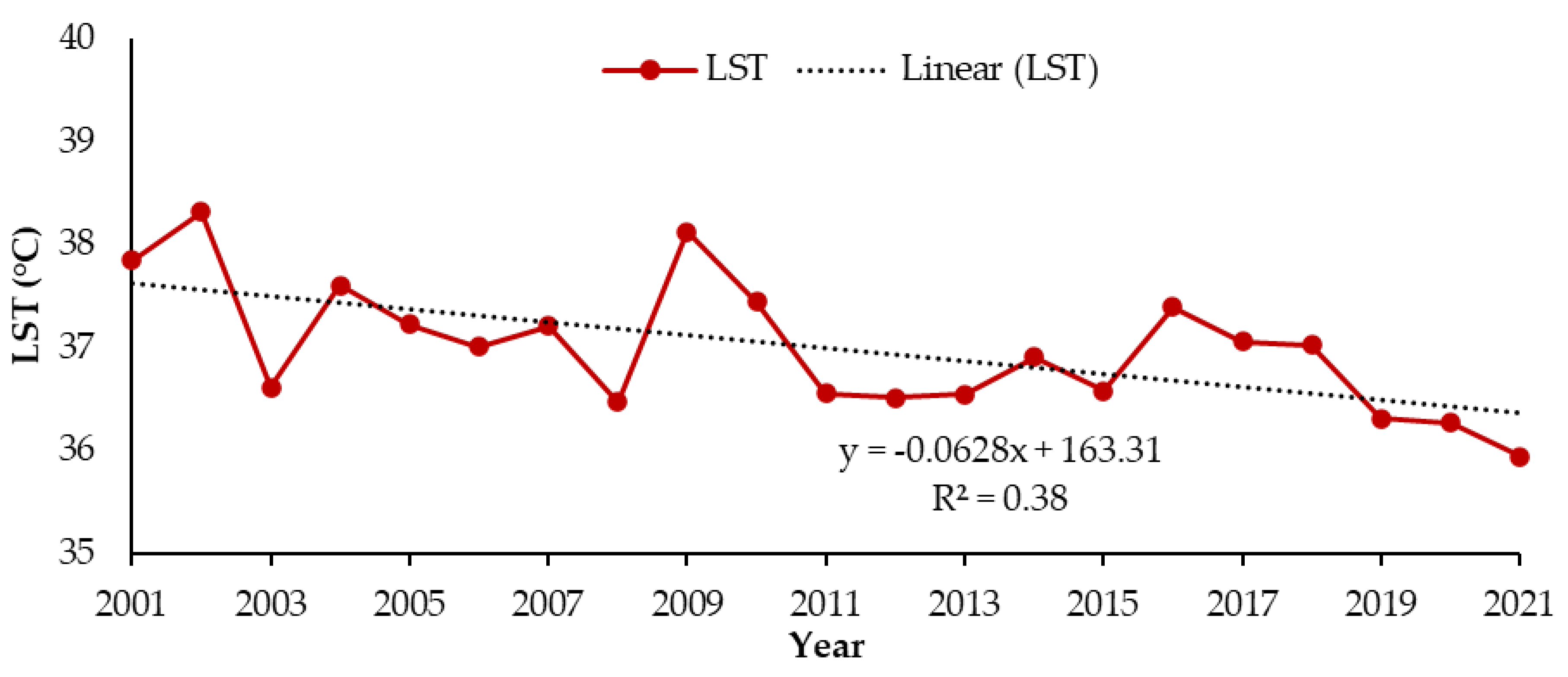


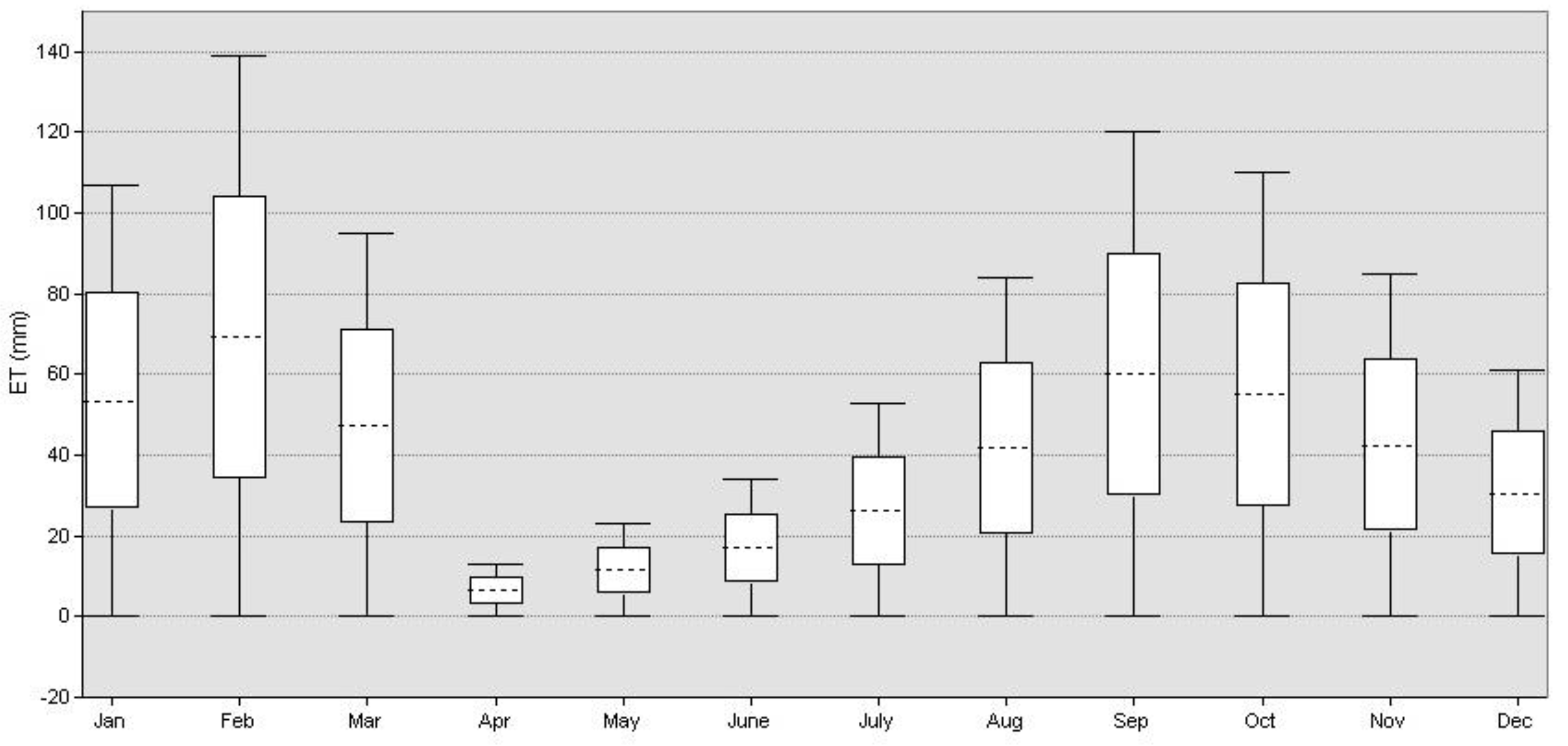
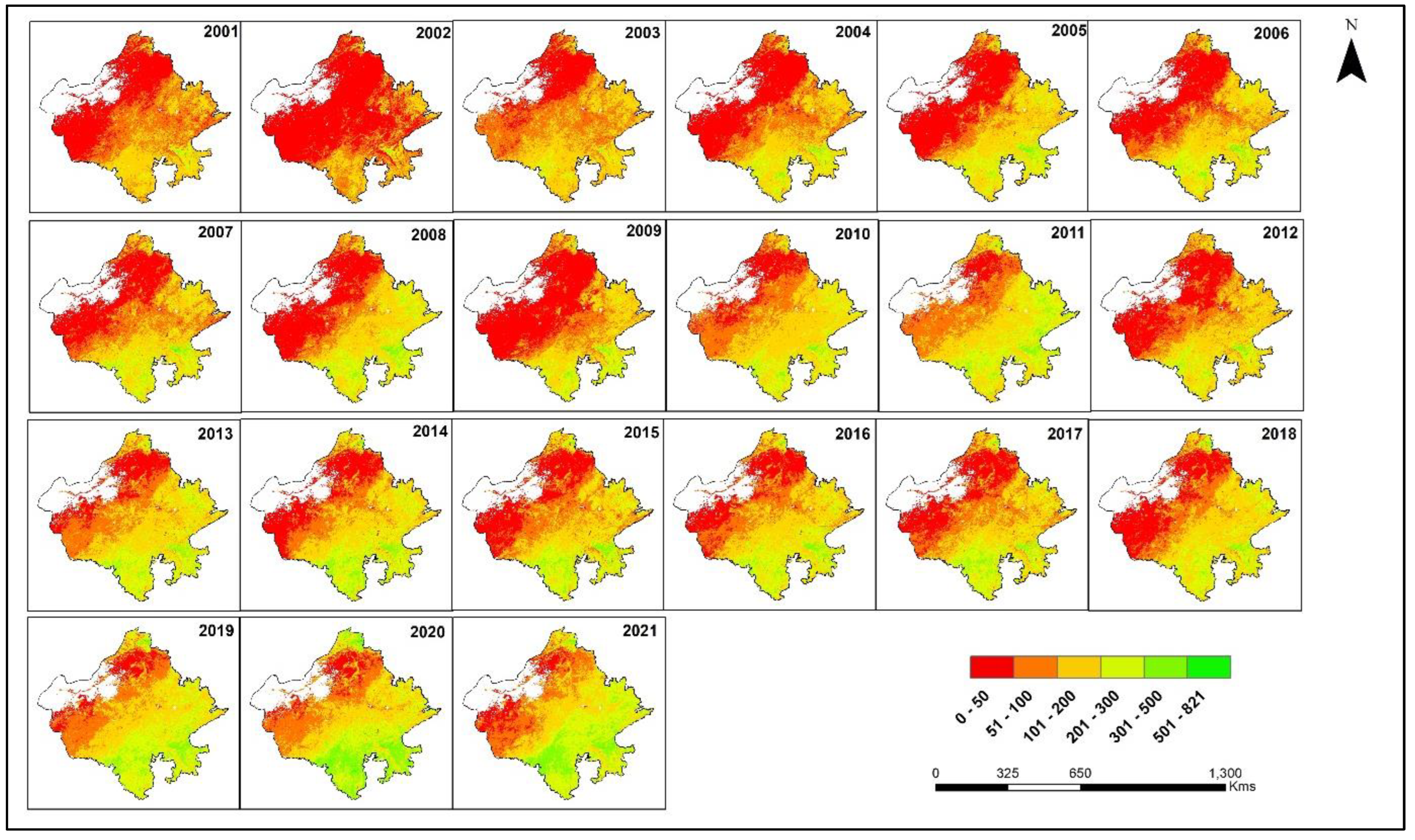





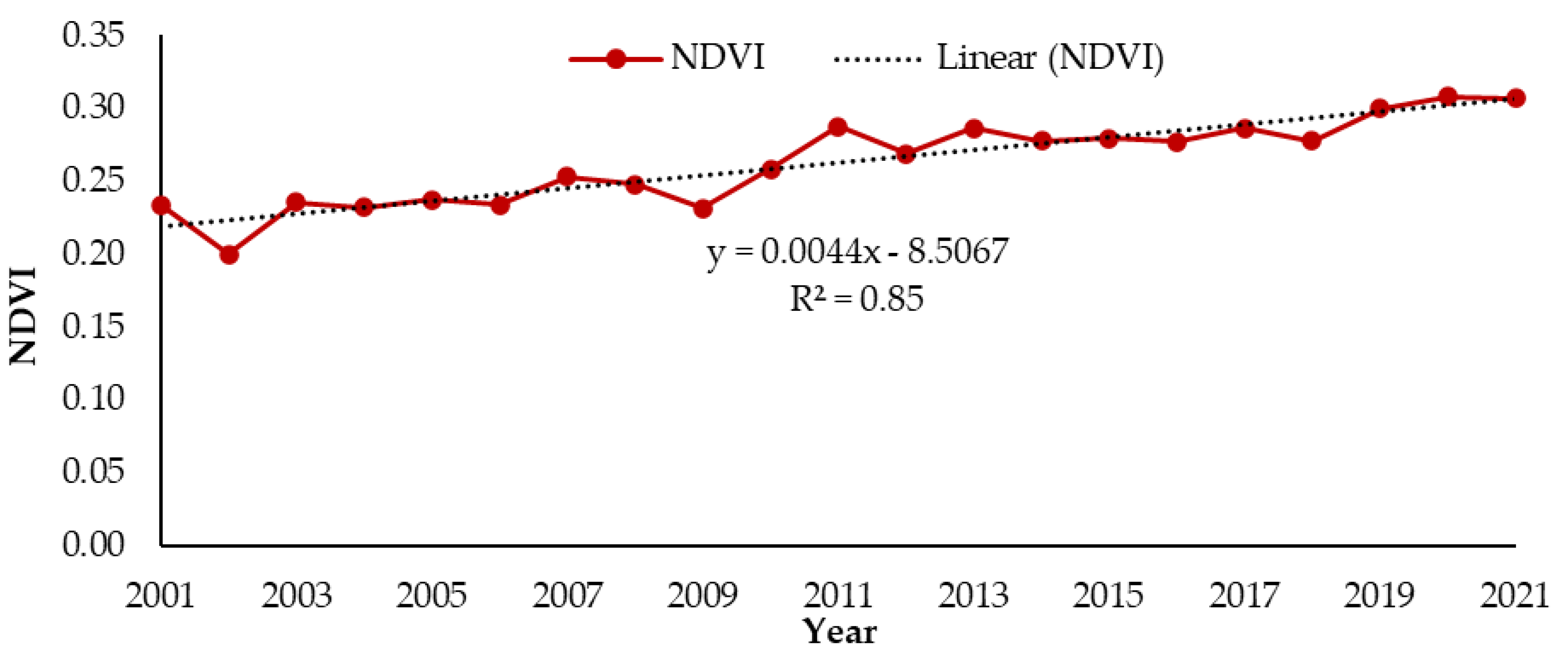





| S. No. | Dataset | Variable | Unit | Temporal Resolution | Spatial Resolution | Period |
|---|---|---|---|---|---|---|
| 1 | MODIS MOD13Q1 | NDVI | - | 16 days | 250 m | 2001–2021 |
| 2 | CHIRPS | Rainfall | mm | Daily | 5 km | 2001–2021 |
| 3 | MODIS MOD11A2 | LST | °C | 8 days | 1 km | 2001–2021 |
| 4 | MODIS MOD16A2GF | ET | kg/m2/8 d | 8 days | 500 m | 2001–2021 |
Disclaimer/Publisher’s Note: The statements, opinions and data contained in all publications are solely those of the individual author(s) and contributor(s) and not of MDPI and/or the editor(s). MDPI and/or the editor(s) disclaim responsibility for any injury to people or property resulting from any ideas, methods, instructions or products referred to in the content. |
© 2023 by the authors. Licensee MDPI, Basel, Switzerland. This article is an open access article distributed under the terms and conditions of the Creative Commons Attribution (CC BY) license (https://creativecommons.org/licenses/by/4.0/).
Share and Cite
Yadav, B.; Malav, L.C.; Singh, S.V.; Kharia, S.K.; Yeasin, M.; Singh, R.N.; Nogiya, M.; Meena, R.L.; Moharana, P.C.; Kumar, N.; et al. Spatiotemporal Responses of Vegetation to Hydroclimatic Factors over Arid and Semi-arid Climate. Sustainability 2023, 15, 15191. https://doi.org/10.3390/su152115191
Yadav B, Malav LC, Singh SV, Kharia SK, Yeasin M, Singh RN, Nogiya M, Meena RL, Moharana PC, Kumar N, et al. Spatiotemporal Responses of Vegetation to Hydroclimatic Factors over Arid and Semi-arid Climate. Sustainability. 2023; 15(21):15191. https://doi.org/10.3390/su152115191
Chicago/Turabian StyleYadav, Brijesh, Lal Chand Malav, Shruti V. Singh, Sushil Kumar Kharia, Md. Yeasin, Ram Narayan Singh, Mahaveer Nogiya, Roshan Lal Meena, Pravash Chandra Moharana, Nirmal Kumar, and et al. 2023. "Spatiotemporal Responses of Vegetation to Hydroclimatic Factors over Arid and Semi-arid Climate" Sustainability 15, no. 21: 15191. https://doi.org/10.3390/su152115191










